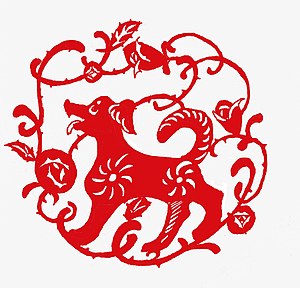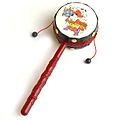
Puppetry is a form of theatre or performance that involves the manipulation of puppets – inanimate objects, often resembling some type of human or animal figure, that are animated or manipulated by a human called a puppeteer. Such a performance is also known as a puppet production. The script for a puppet production is called a puppet play. Puppeteers use movements from hands and arms to control devices such as rods or strings to move the body, head, limbs, and in some cases the mouth and eyes of the puppet. The puppeteer sometimes speaks in the voice of the character of the puppet, while at other times they perform to a recorded soundtrack.

The art of paper cutting in China may date back to the 2nd century CE, when paper was invented by Cai Lun, a court official of the Eastern Han Dynasty.

Weifang is a prefecture-level city in central Shandong province, People's Republic of China. The city borders Dongying to the northwest, Zibo to the west, Linyi to the southwest, Rizhao to the south, Qingdao to the east, and looks out to the Laizhou Bay to the north. Its population was 9,386,705 at the 2020 census, of whom 3,095,520 lived in the built-up area made up of four urban districts and Changle County largely being urbanized.
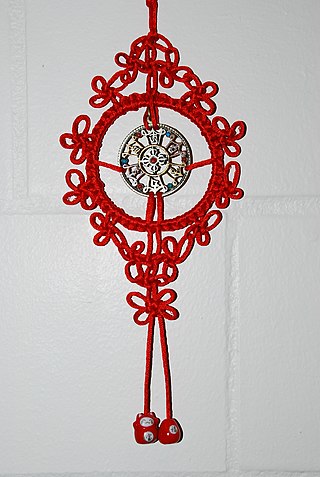
Chinese knotting, also known as zhongguo jie, is a traditional Chinese folk art with strong ties to Buddhism and Taoism. A Chinese knot is made from a single length of cord that is woven into many different shapes. Each shape has its own symbolic meaning. The most common color used in Chinese knotting is red, a color associated with luck in traditional Chinese culture, although any color can be used. Charms, beads, and jade may be incorporated into a Chinese knot. It is believed that Chinese knotting originated to record information and exchange messages before the common use of writing. Traditionally, Chinese knots acted as good luck charms that could ward off evil spirits. Chinese knots are used today to decorate homes during festivities and celebrations and are also commonly seen in traditional jade jewelry and traditional Chinese clothing.

Glove puppetry is a type of opera using cloth puppets that originated during the 17th century in Quanzhou or Zhangzhou of China's Fujian province, and historically practised in the Min Nan-speaking areas such as Quanzhou, Zhangzhou, the Chaoshan region of Guangdong, and other parts of southern China. It had since established itself contemporarily as a popular art form in Taiwan.

Shadow play, also known as shadow puppetry, is an ancient form of storytelling and entertainment which uses flat articulated cut-out figures which are held between a source of light and a translucent screen or scrim. The cut-out shapes of the puppets sometimes include translucent color or other types of detailing. Various effects can be achieved by moving both the puppets and the light source. A talented puppeteer can make the figures appear to walk, dance, fight, nod and laugh.

Papercutting or paper cutting is the art of paper designs. Art has evolved all over the world to adapt to different cultural styles. One traditional distinction most styles share is that the designs are cut from a single sheet of paper as opposed to multiple adjoining sheets as in collage.

Togalu gombeyaata is a puppet show unique to the state of Karnataka, India. Togalu gombeyaata translates to "a play of leather dolls" in the native language of Kannada. It is a form of shadow puppetry. Karnataka Chitrakala Parishat has undertaken research on this art and has a good collection of leather puppets.

A puppet is an object, often resembling a human, animal or mythical figure, that is animated or manipulated by a person called a puppeteer. The puppeteer buses movements of their hands, arms, or control devices such as rods or strings to move the body, head, limbs, and in some cases the mouth and eyes of the puppet. The puppeteer often speaks in the voice of the character of the puppet, and then synchronizes the movements of the puppet's mouth with this spoken part. The actions, gestures and spoken parts acted out by the puppeteer with the puppet are typically used in storytelling. Puppetry is a very ancient form of theatre which dates back to the 5th century BC in Ancient Greece. There are many different varieties of puppets, and they are made from a wide range of materials, depending on their form and intended use. They range from very simple in construction and operation to very complex.

Qinhuai Lantern Fair, also known as Jinling Lantern Fair, Jinling Lantern Festival, and officially named Lantern Fair on Qinhuai River, is a popular folk custom celebration of the Lantern Festival in the Nanjing area.

Seal knob, sometimes also seal sculpture, refers to carving or small decorative reliefwork at the top or side of a seal. The associated carving technique is called knob carving, a traditional technique that originated in ancient China and later spread to other East Asian countries, including Japan and Korea.

Hardstone carving, in art history and archaeology, is the artistic carving of semi-precious stones, such as jade, rock crystal, agate, onyx, jasper, serpentinite, or carnelian, and for objects made in this way. Normally the objects are small, and the category overlaps with both jewellery and sculpture. Hardstone carving is sometimes referred to by the Italian term pietre dure; however, pietra dura is the common term used for stone inlay work, which causes some confusion.

Fruit pit carving is a Chinese folk handicraft in which the pits of peach, apricot, walnut, Chinese olive, yumberry and other drupes are used to create minute patterns of the Buddha, nature, or the Chinese zodiac that are said to repel evil spirits. The carved pits are also used to create jewelry and decorations. However, the art is now facing extinction because few black olive trees are planted in China and there are very few people interested in learning this art. Olive core carving has recently been recognized as an Intangible Cultural Heritage of the Guangdong Province of China.

Sugar painting (糖画) is a form of traditional Chinese folk art using hot, liquid sugar to create two dimensional objects on a marble or metal surface. Melted sugar is carried by a small ladle made by bronze or copper. After it cools, it will be stuck to a bamboo stick and removed using a spatula. Three dimensional objects can be created by laying solidified sugar.

Much traditional Chinese art was made for the imperial court, often to be then redistributed as gifts. As well as Chinese painting, sculpture and Chinese calligraphy, there are a great range of what may be called decorative or applied arts. Chinese fine art is distinguished from Chinese folk art, which differs in its style and purpose. This article gives an overview of the many different applied arts of China.
Annie Katsura Rollins is an American artist, scenic designer, and puppeteer. She specializes in traditional Chinese shadow puppetry.
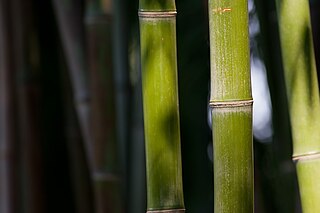
Bambooworking is the activity or skill of making items from bamboo, and includes architecture, carpentry, furniture and cabinetry, carving, joinery, and weaving. Its historical roots in Asia span cultures, civilizations, and millennia, and is found across East, South, and Southeast Asia.
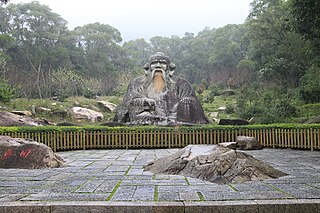
Minnan culture or Hokkien/Hoklo culture, also considered as the Mainstream Southern Min Culture, refers to the culture of the Hoklo people, a group of Han Chinese people who have historically been the dominant demographic in the province of Fujian in Southern China, Taiwan, and certain overseas Chinese communities in Southeast Asia, such as Singapore, Malaysia, the Philippines, Indonesia, Myanmar, Southern Thailand, Cambodia, Southern Vietnam, etc.

Traditional Malaysian art is primarily composed of Malay art and Bornean art, is very similar with the other styles from Southeast Asia, such as Bruneian, Indonesian and Singaporean. Art has a long tradition in Malaysia, with Malay art that dating back to the Malay sultanates, has always been influenced by Chinese, Indian and Islamic arts, and also present, due to large population of Chinese and Indian in today's Malaysian demographics.

Qinhuai lantern is the traditional art of Jurong City, Jiangsu Province, in China, and part of the national intangible cultural heritage of China. Qinhuai lantern, also known as "Jinling lantern" and "Nanjing lantern", is one of the representative folk arts in Nanjing. The origin of Qinhuai lantern colour can be traced back to the Eastern Wu period, it draws on the traditional Chinese paper tie, painting, calligraphy, paper cutting, shadow puppetry, embroidery, sculpture and other arts, in the production of integrated carpentry, lacquer, painting, carving, clay sculpture, knotting and many other technical means. Qinhuai has a variety of lanterns, reaching from the traditional lanterns to lotus lanterns and lion lanterns. The variety and design of lantern works represents also current events to the time of design, such as ocean-going ships, carrier rockets, urban construction, mountain and forest landscapes.
